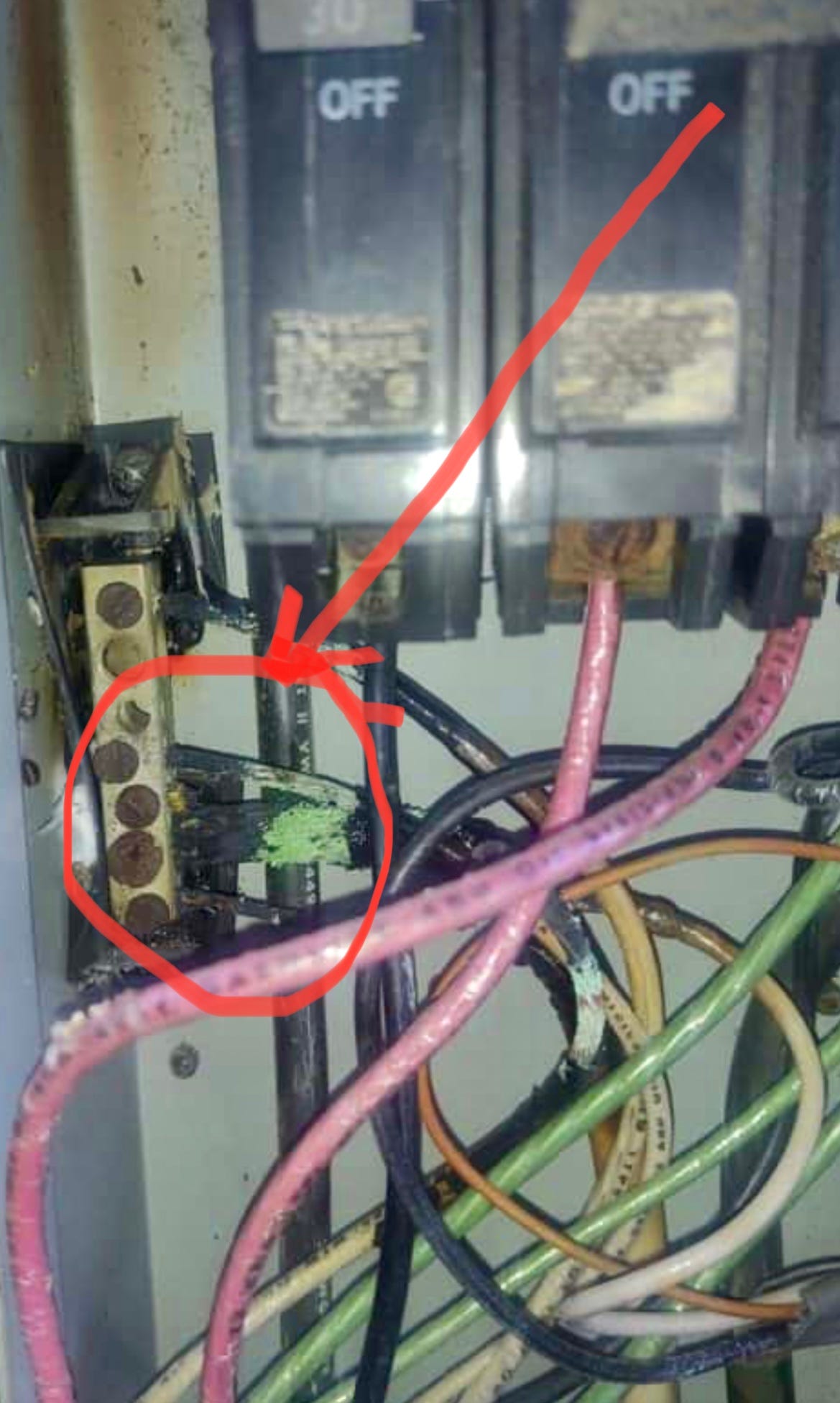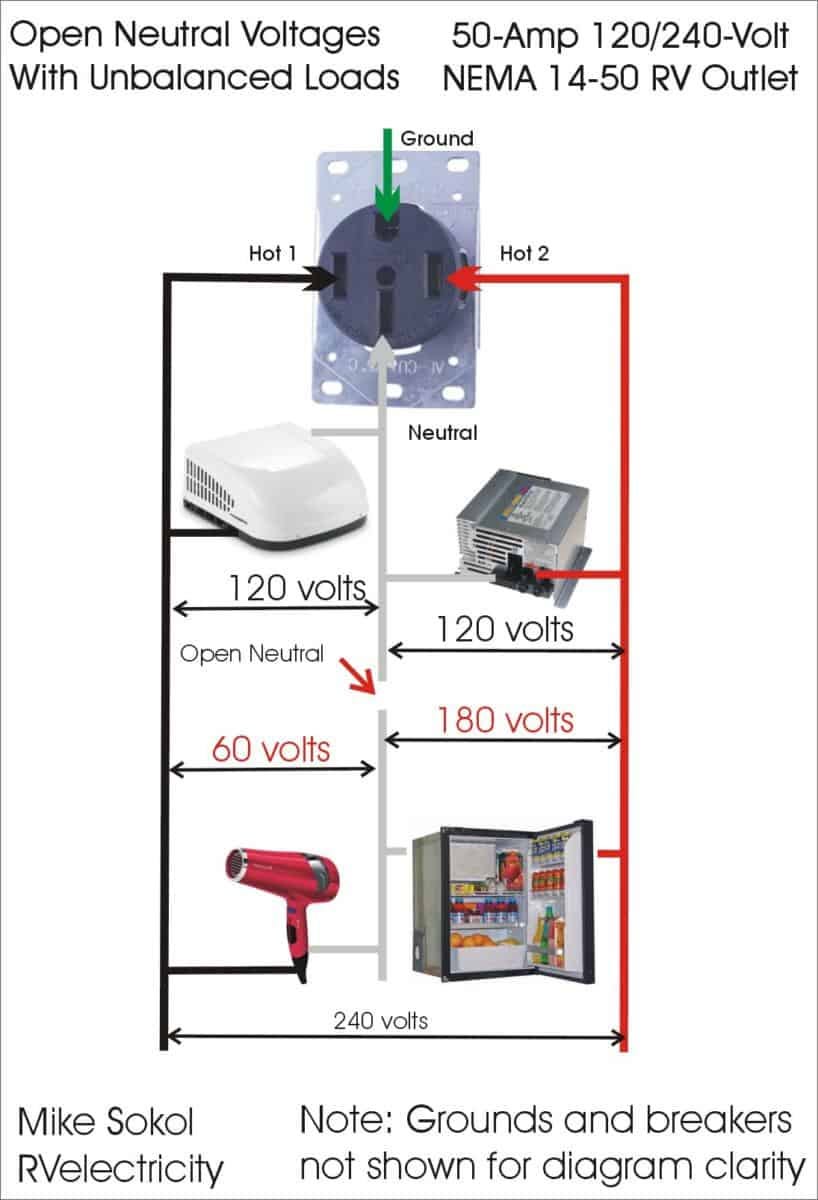Open neutral dangers
A 50-amp, 240-volt pedestal outlet is only safe when the neutral is intact!
Dear Readers,
This picture and story recently showed up on my Facebook group. It’s a great reminder of why you really need an advanced surge protector on your RV (commonly called an EMS or Total Power Protection).
See the burned wiring below…
Note that this particular pedestal would have measured perfectly fine with an AC meter, but once the RV was hooked up and drawing power, the neutral conductor opened up and applied way more than 120 volts to one-half of the RV’s electrical system. Unfortunately, many campgrounds don’t use licensed electricians for their electrical work, so this sort of mis-wiring is more common that you might imagine. And few campground pedestals are inspected or maintained on any sort of regular schedule, so any time you plug into a campground pedestal you roll the dice.
These advanced surge protectors are sold by the big three companies: Progressive Industries, Surge Guard and Hughes Watchdog. I like the Surge Guard products the best because I’ve tested all three of them in my FunkWorks Lab and think they have the best engineering.
Why is an open neutral dangerous?
A 50-amp pedestal outlet has two hot legs 180 degrees out of phase with 240 volts leg-to-leg. The neutral is what divides that 240-volt service in half to 120/120 volts on each leg.
If the neutral fails, that 240 volts can divide unevenly into 140/100 volts, 160/80 volts or even 200/40 volts. Of course, any electrical appliances on the high-voltage leg will be damaged in seconds.
An advanced surge protector is cheap insurance!
In any event, I think that the $300 to $400 cost of an Advanced/Total-Protection surge protector is cheap insurance to help keep your RV’s electrical system from frying. And open neutral on a 50-amp service will almost certainly cause a lot of expensive damage that could take months to even get the repair parts. So be proactive and don’t wait until electrical damage occurs.
But be aware that a surge-only protector won’t do anything to disconnect your RV from an overvoltage failure.
Here’s what a reader posted on my Facebook group.
I finally decided that I should be using a power analyzer before connecting the RV. First time I’ve ever connected to a 50A service with an open neutral. After spending the last 50+ years as an electrician you would think I’d know better than hook into an unknown source. But really, that’s what we do every time we move to another site.
We were in the trailer just getting set up when the bathroom filled up with smoke! We thought one of the neighbors was burning popcorn. I went outside and couldn’t smell it anymore. Came back inside and sniffed my way to the bathroom door. The good news is that our trailer didn’t burn up and we can get through this trip without having to go home. Weather is perfect, and one of my golf teammates is here to visit with.
Park manager was here earlier and it sounds like they will cover our repair costs. Nice start to the 72nd year!
It’s unclear in the photo but looks to me like last time there was an issue with this receptacle, they replaced it with a household style rather than a RV pedestal style. The wires they used for 50A were #10 THHN. The handyman would probably have been ok for a while longer if he would have replaced the burnt up feeder neutral and melted neutral buss.
All we lost was the power converter and the circuit board in a Fantastic fan. It could have been so much worse. I’ll be installing a hinged access door to the converter, so if future issues arise, I can get an extinguisher to it quicker.
Be safe, folks! – Jeff
It’s me (Mike) again…
Thanks for your great write-up, Jeff. An open neutral on a 50-amp outlet can cause lots of damage, so you need to protect your RV from over-voltage conditions. An Advanced/Total-Protection Surge Protector is the best way.








I just added a close-up pic of the burned neutral conductors with a circle and arrow pointing to the failure.
Mike, you posted an article several years ago suggesting testing the pedestal before hooking up with a 50 amp splitter and a 120 volt tester. ( 50 amp male plug that splits into (2) 15 amp female pigtails). This enables testing each leg with the 120 volt tester for voltage outputs as well as polarity.
I had a recent encounter at a campground that checked out okay with that method until I connected my Southwire Surgeguard SMS (34951). The EMS indicated there was an open neutral and would not allow the current to flow. The irony , that was newly installed pedestal at an old campground. Upon further checking with management it was installed by their handyman.
Always check first before assuming that it looks good it must be good!!!